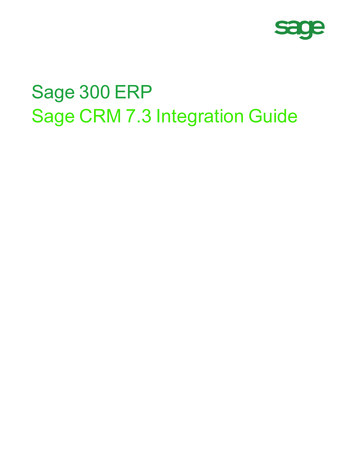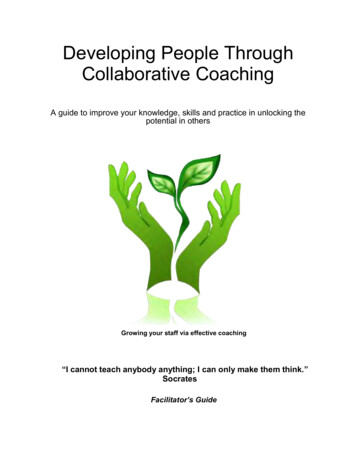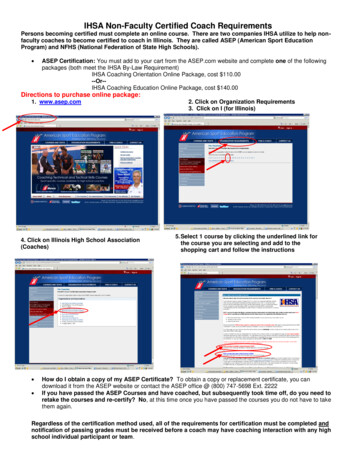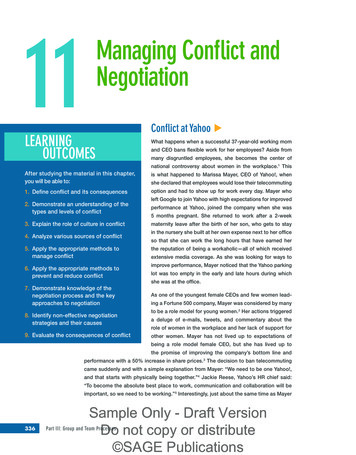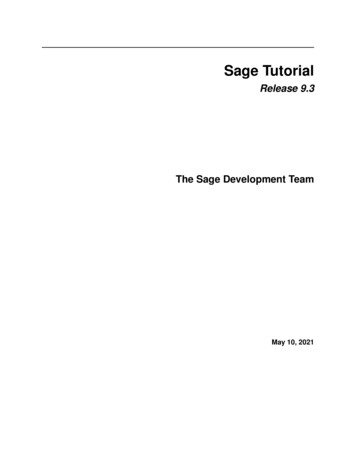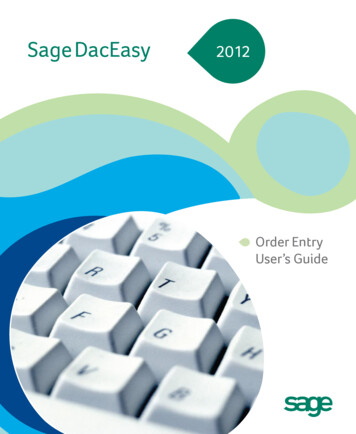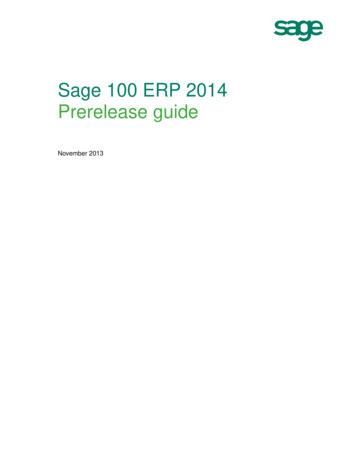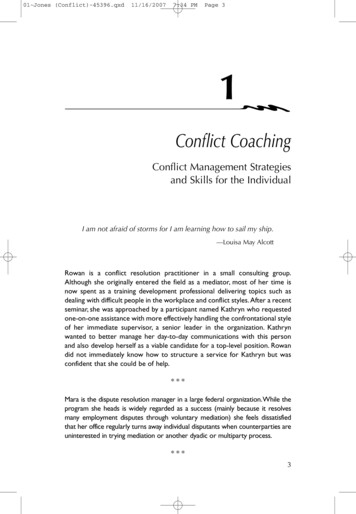
Transcription
01-Jones (Conflict)-45396.qxd11/16/20077:34 PMPage 31Conflict CoachingConflict Management Strategiesand Skills for the IndividualI am not afraid of storms for I am learning how to sail my ship.—Louisa May AlcottRowan is a conflict resolution practitioner in a small consulting group.Although she originally entered the field as a mediator, most of her time isnow spent as a training development professional delivering topics such asdealing with difficult people in the workplace and conflict styles. After a recentseminar, she was approached by a participant named Kathryn who requestedone-on-one assistance with more effectively handling the confrontational styleof her immediate supervisor, a senior leader in the organization. Kathrynwanted to better manage her day-to-day communications with this personand also develop herself as a viable candidate for a top-level position. Rowandid not immediately know how to structure a service for Kathryn but wasconfident that she could be of help.***Mara is the dispute resolution manager in a large federal organization.While theprogram she heads is widely regarded as a success (mainly because it resolvesmany employment disputes through voluntary mediation) she feels dissatisfiedthat her office regularly turns away individual disputants when counterparties areuninterested in trying mediation or another dyadic or multiparty process.***3
01-Jones (Conflict)-45396.qxd11/16/20077:34 PMPage 44 Chapter 1David and Linda are the respective heads of human resources and organizational learning in a national insurance company. They have teamed up tocreate a positive conflict culture in the organization.They are especially interested in the prospect of strengthening supervisor-supervisee relationships bydeveloping supervisors’ conflict management skills.It is striking that while the conflict resolution field has numerous processesfor two or more clients, offerings for the individual client are relativelyunderdeveloped. We believe conflict coaching is a promising means ofaddressing this gap. Conflict coaching is a process of conflict interventioninvolving one disputant/client and one conflict resolution professional.Given the resonance of one-on-one professional coaching and the fact thatit is often not feasible to engage two or more parties simultaneously, there isa need to advance this process. With the body of conflict communicationtheory and research, there is a bountiful reservoir on which to draw.Each of the brief opening cases represents an opportunity to introducethe practice of conflict coaching. Rowan could coach Kathryn regardingher current tensions with her supervisor and more broadly as a promising senior-level leader in a particular organizational conflict culture.Mara is in a position to add conflict coaching as an alternative disputeresolution (ADR) process offering within her organization, possibly withinternal capacity or with an outside collaborator. David and Linda may findit appealing to train supervisors in a tailored conflict coaching model as away of strengthening the supervisor-supervisee relationship. Obviously,many other conflict coaching scenarios are also possible.In this chapter, we offer a general definition of conflict coaching andexplore its two main sources of development, namely the executivecoaching and conflict resolution communities. We then propose likelydrivers of continued development for conflict coaching before presenting some important conflict coaching principles. The current chapterconcludes with a number of reasons why the conflict resolution community, in particular, has much to contribute and gain by developing conflict coaching. This sets the stage for the next chapter, which introducesthe Comprehensive Conflict Coaching model, elaborated in detailthroughout the remainder of the book.A General Definition of Conflict CoachingConflict coaching is a process in which a coach and client communicateone-on-one for the purpose of developing the client’s conflict-related
01-Jones (Conflict)-45396.qxd11/16/20077:34 PMPage 5Conflict Coaching 5understanding, interaction strategies, and interaction skills. The definitionis broad in that it encompasses different forms of communicationbetween the coach and client. Conflict coaching, as it is explored andrefined here, is primarily understood as a face-to-face interaction withoccasional use of print-based activities and resources; however, it can alsoreasonably take place via the telephone, Internet, or other oral, written,and/or visual media. The definition is also expansive, as it permits different kinds of conflict-related conversations to take place, including butnot limited to ways of making sense of conflict, general plans for activelymanaging conflict, and specific communication behaviors for the client topossibly enact. While contextual issues (including interpersonal, organizational, and cultural factors) are certainly central to any coaching conversation, they are not included in the definition; this allows for theapplication of conflict coaching in a wide variety of relational circumstances. Finally, this basic definition allows significantly different coachingmodels to be proposed. For instance, the model proposed in this booktakes a moderate position on the use of the coach’s expert knowledgebase within the coaching session. Some may argue for stronger use ofthe coach’s perspective, while others may argue that it should be morerestrained.Sources of Development: An Overviewof Conflict and Coaching in the ExecutiveCoaching and Conflict Resolution FieldsOver the past two decades, the concepts of conflict and coaching havebeen addressed in combination by a number of different scholars andpractitioners. These writings can be grouped in two general categories,although it should be emphasized that they basically developed simultaneously and sometimes thematically overlap. The first category is madeup of work from the executive coaching field that, usually incidentally,mentions conflict as playing a role in the executive coaching process. Thesecond category captures work from an explicit conflict resolution pointof view.BACKGROUND ON EXECUTIVE COACHINGExecutive coaching is usually one-on-one professional developmentwithin an organizational setting. Tobias (1996) noted that the term firstappeared in business settings in the late 1980s and came about not as
01-Jones (Conflict)-45396.qxd11/16/20077:34 PMPage 66 Chapter 1a strikingly new concept or practice but as a more appealing label fora practice of consultation offered to managers and senior leaders that hadevolved over time. A thorough review of the literature generally supportsthis view (Kampa-Kokesch, 2001). Berglas (2002) stated that there were2,000 executive coaches in 1996 and at least 10,000 in 2002, and thereare projected to be more than 50,000 by 2007.Executive coaching can be narrow to expansive in terms of topicsand duration. It has been used to teach specific skills, improve job performance, prepare for professional advancement, and assist with broaderpurposes such as an executive’s agenda for major organizational change(Witherspoon & White, 1996).Diedrich (1996) worked to modify an executive’s style, assist executives in adjusting to change, help in developmental efforts, and provideassistance to derailed executives. Kiel, Rimmer, Williams, and Doyle(1996) characterized approximately one-quarter of their clients as needing help preparing for advancement, a second quarter having performance problems, and the remaining half as needing to reinforce theirexisting areas of strength. Levinson (1996) noted simply that executivecoaching largely involves supporting clients as they advance in terms ofadaptive work behaviors. Those with a stronger popular emphasis alsocommonly include life coaching within an executive coaching framework. For instance, Morgan, Harkins, and Goldsmith (2005) make distinctions in terms of coaching leaders and behavioral coaching, careerand life coaching, coaching for leadership development, coaching fororganizational change, and strategy coaching. Given the topical breadthof executive coaching, it is not surprising that the coaching relationshipmay be limited to one or two meetings or extend over many years.CONFLICT AND COACHING INTHE EXECUTIVE COACHING COMMUNITYAs briefly introduced earlier, the terms conflict and coaching seem to havebeen first joined together in 1994 when Stern (1994) commented on thepotential importance of addressing the topic of conflict managementwithin executive coaching work. He noted that executive coaching maybe relevant in situations where executives trigger conflict ineffectively orperpetuate destructive conflict.Kilburg (2000), a prominent executive coaching scholar who haswritten numerous articles for academically grounded consulting psychologists, wrote a book chapter titled “Working with Client Conflicts.” Thechapter, consistent with the overall book and Kilburg’s general perspective, addressed clients’ internal and external conflicts as understood in
01-Jones (Conflict)-45396.qxd11/16/20077:34 PMPage 7Conflict Coaching 7terms of a combined psychodynamic and systems approach. The chapteris a notable contribution to conflict coaching, especially but not exclusively for those working from a therapeutic background. As wellas providing general guidelines, Kilburg offered suggestions for coachesworking with executives who are effecting change, managing boundariesand limits, dealing with spiritual and moral issues, and valuing diversity.Kets de Vries (2005), another executive coaching author workingfrom a psychotherapeutic orientation, combined the concepts of conflictand coaching in terms of more broadly addressing group-based leadership coaching. He proposed that there are important benefits to carryingout leadership coaching in a group setting, in part because it allows foreffective conflict resolution.Coaching for conflict is integral to the executive coaching fieldbecause conflict permeates the executive’s work world. “Coping withinternal and external problems forms the foundation of managerialwork, and these problems almost always consist of some form of humanconflict” (Kilburg, 2000, p. 217).CONFLICT AND COACHING IN THECONFLICT RESOLUTION COMMUNITYThe need for a one-on-one conflict resolution process, in cases whereonly one party was present for mediation, emerged at MacquarieUniversity in Australia in 1993 (Tidwell, 1997). A response to this needwas formalized and put into practice on campus three years later andwas known as “problem solving for one.” This process involved a six-stepmodel based on the generation of multiple solutions and the selection ofoptimal solutions through a cost-benefit analysis.Conflict coaching seems to have first been named as such in and activelypracticed in North America as of January 1996 at Temple University inPhiladelphia, Pennsylvania (Brinkert, 1999). The campus conflict resolutionprogram was experiencing a low demand for mediation and, consequently,conflict coaching was developed under the co-leadership of professorsJoseph P. Folger and Tricia S. Jones. Conflict coaching thereafter becameone of the conflict-related services promoted (Jameson, 1998) and engagedin by the Temple campus community. While conflict coaching at Templewas limited to conflict styles coaching until spring 2000 (Brinkert, 2000),it was expanded shortly thereafter to include such subtypes as coaching forconfrontation, coaching for diversity, and coaching in possible preparationfor mediation. Conflict coaching remains a central conflict resolution service offered on Temple’s campus and, year-to-year, is consistently put intopractice more often than mediation.
01-Jones (Conflict)-45396.qxd11/16/20077:34 PMPage 88 Chapter 1In the current decade, conflict and coaching have been addressed inthe literature in ways that differ from the definition of conflict coachingpresented at the outset of this chapter. Keil (2000) applied the coachingmetaphor to intervening with work teams. Blitman and Maes (2004)suggested ways that skills and behaviors associated with sports coachesmay be helpful within mediation. An article in Personnel Today (NHSConflict, 2005) noted the need for a massive amount of “conflict coaching training” (or group-based training meant to assist professionals inworking through conflict with clients) in Great Britain’s National HealthService (NHS). The NHS Counter Fraud and Security ManagementService (CFSMS) was instructed to train 750,000 employees in techniques to calm people in potentially violent situations. The training isreportedly behind schedule but is to be carried out by 2008.Conflict coaching as a one-on-one process has grown in significanceover the past 10 years. It is a service marketed by a growing number offor-profit and not-for-profit conflict resolution organizations and individual practitioners. It has visibility on the relatively popular www.mediate.com Web site and appears to be a growing topic of interest atthe annual Association for Conflict Resolution conference.The emergence of conflict coaching as a recognizable and valuedintervention process is perhaps most evident given that highly visibleorganizations are adopting the practice. Cloke and Goldsmith (2000)noted the opportunity to use coaching as one conflict resolution methodin organizations. More recently, Weiss and Hughes (2005) recommended,as one of six strategies, that companies use the escalation of conflict asan opportunity for coaching. They went on to describe how IBM executives receive training in conflict management and are provided withonline resources to assist them in coaching others. C. Noble (personalcommunication, April 9, 2007) developed a proprietary conflict coaching model that has been used for the peer conflict coaching programin the Transportation Security Administration, a division of HomelandSecurity. As Guttman (2005) commented, conflict coaching is relevantfor building leadership competency. As such, it is of interest to trainingdevelopment, human resource, and other professionals who regularlyfacilitate such initiatives.LIKELY DRIVERS OF CONTINUEDDEVELOPMENT FOR CONFLICT COACHINGThis section identifies some reasons why conflict coaching is likely toexpand in the coming years. Most of these drivers of continued development flow out of the early emergence of conflict coaching as outlined
01-Jones (Conflict)-45396.qxd11/16/20077:34 PMPage 9Conflict Coaching 9above. Drawing these together arguably demonstrates a promising futurefor conflict coaching.The continued concern with conflict management in a complex serviceeconomy. Ongoing emphasis on interpersonal, team, and organizationalcommunication in a complex global service economy will likely meanthat organizations will make investments in one-on-one assistance aswell as other types of professional development for their leaders, managers, and frontline workers. Effective conflict management is an integralpart of an economy emphasizing service and communication. The continued growth of the global service sector and ongoing collaboration andcompetitiveness in the sector seem to suggest growing opportunities tooffer conflict coaching. This trend also suggests growth for the conflictmanagement field in general. There will likely be increased demand forconflict coaching theory and research as well as for practice tools asestablished universities increasingly and visibly develop coaching programs, especially within their business schools (for instance, GeorgetownUniversity, INSEAD, the University of Cape Town, and the University ofPennsylvania).The strong commitment in many areas of society to productively andethically manage conflict. Again, this is a trend that broadly supports thegrowth of the conflict management field. Organizations and individualsfrequently have expectations that conflicts should be handled appropriately. Even an all-star organizational performer may not be tolerated ifhe or she drives other important or promising members from the organization or is otherwise significantly out of step with the culture andgoals of the organization.The continued need for a one-on-one ADR process. While ADR may beideally suited to purely dyadic or group interventions because of the waythat it provides insights and tools for improved interaction, there is stilla need to make ADR accessible to individuals. Many clients and ADRprofessionals acknowledge this reality. Dyadic and multiparty options maynot be possible, at least not immediately. It is well accepted among mediators that many mediation referrals do not lead to mediation because oneor more parties is reluctant to participate in that process. These partiesmay find it more appealing to try conflict coaching. Conflict coachingmay function as a way of increasing awareness of options for addressingthe conflict, including the availability of traditional ADR processes. Forsome, conflict coaching may be more attractive than other processes forreasons of perceived efficiency and/or effectiveness.The need for a process that has a strong and tailored skills emphasis.While ADR processes such as mediation offer spaces where partiescan interact in more productive ways, and while ADR training activities
01-Jones (Conflict)-45396.qxd11/16/20077:34 PMPage 1010 Chapter 1typically introduce new knowledge and skills in a general manner, conflictcoaching offers a unique blend of possibilities for clients. Conflict coachingrepresents a considerable breakthrough as a conflict management process,as it provides clients with strategies and skills customized to their conflictsituations in a relationship rich with interaction. In this respect, conflictcoaching complements existing ADR process options and training opportunities. It promises something different, for example, than “mediation forone” or ”training for one.” It is a fundamentally different opportunity foraddressing conflict more appropriately and effectively. Further, conflictcoaching may put the unused and underused existing talents and abilitiesof ADR professionals into use.Increasing market recognition and demand. The term conflict coachingand its basic practice have gained common currency, particularly as theyhave been visibly adopted by large organizations such as IBM (Weiss &Hughes, 2005). The application of conflict coaching within a growing listof organizations has left many with the sense that it is successful. Ofcourse, peer-reviewed research is certainly needed to justify this view. Insome cases, individuals have self-initiated a coaching-type relationshipwith a trusted ADR professional because they perceived the ADR professional as having expertise that would be valuable to access in a oneon-one format. Also, some ADR and executive coaching professionalshave observed more generalized demand for these services and havebranded their services as executive coaching and/or conflict coaching inorder to attract clients. More and more individuals have some awarenessof the term conflict coaching both inside and outside the conflict management field.Increasing interest in the use of conflict coaching as a way to integrateand promote existing ADR processes. The fact that there are a number ofestablished ADR processes does not solve the practical challenge of creating visibility, including providing ways for individuals to determinetheir appropriateness. Given the habit and preference of most individuals to make one-on-one inquiries regarding conflict-related issues, itseems that most would be amenable to an ADR triage process that isindividual in nature. Conflict coaching may be used to introduce mediation, as an entry point in the ombuds process, and to make a more robustorganizational dispute resolution system. During intake for a mediation,the mediator typically talks to each party to explain the process and,depending on the type of mediation, coaches them so they can interactin a productive manner. Many mediators do not learn this skill in theirtraining. Ombuds offices may be involved in transitioning parties tomediation but often do much more, as these offices attract parties withmany different concerns (Warters, 2000). Conflict coaching may be well
01-Jones (Conflict)-45396.qxd11/16/20077:34 PMPage 11Conflict Coaching 11suited to much of the person-to-person problem solving in whichombudspeople engage. And it may help open up the ombudsperson roleto be more systemic in nature, as has been called for in that professionalspecialty (Wagner, 2000), by incorporating a system of conflict intervention options. This could conceivably result in greater numbers of individuals making use of established ADR processes.There is evidence that organizational dispute resolution systems thathave components in alignment are more effective (Bendersky, 2003).Therefore, it is not unreasonable to suggest that having more components in alignment (i.e., adding conflict coaching to the mix of ADRprocess offerings) might further enhance effectiveness. The success ofexisting in-house dispute resolution systems, the best of which resolveup to 90 percent of employee complaints internally (Wexler, 2000), suggests that this is a path worth pursuing.The likely emergence of conflict coaching as a recognizable executive coaching specialty. Executive coaching continues to have considerable appealwithin a wide range of workplace circles. Although some of this appealmay come from the breadth of the process, it is reasonable to assumethat there will be increased specialization within executive coaching.Expertise is specialized by nature. Therefore, all other considerations beingequal, an individual needing or wanting to work on a conflict-related issuewill probably seek out and work with a conflict communication specialist. Conflict communication is central to supervising others, coordinatingwith peers, influencing upward in the organizational hierarchy, and managing relationships with clients and other external constituencies. Rundeand Flanagan (2007) insisted that the ability to handle conflict is a topskill of successful leaders today and is essential to an organization’s competitiveness. These authors pointed out that the much talked about needfor leaders to be more emotionally competent is intimately linked withtheir need to be more conflict competent. Runde and Flanagan alsoemphasize that leaders will themselves admit that there are high costsassociated with ineffectively managing conflict.Continued support and direct involvement from organizational communication professionals who see value as an add-on or alternative to consulting, training, other types of coaching, etc. There are a number of human resourceinsiders, external consultants, training development professionals, executivecoaches, and others who have experienced the need for an allied or alternative intervention in the form of conflict coaching. A human resource specialist or external consultant might not only support a senior leader indefining a strategic message, but he or she might also assist the leader in determining an approach and developing related skills to execute conflict-relatedaspects of the overall strategy.A training development professional might see
01-Jones (Conflict)-45396.qxd11/16/20077:34 PMPage 1212 Chapter 1the opportunity to assist a participant in developing conflict awareness,strategy, and skills in a more specialized format due to the participant’sunique abilities, responsibilities, challenges, and/or opportunities. Somehuman resource specialists, organizational communication consultants, andtraining development professionals may want to hone an additional expertise as a conflict coach. Others will want to focus on existing areas of expertise and refer conflict coaching work to colleagues.Continued development of conflict coaching curricula in graduate andundergraduate programs. When academic programs begin to develop coursesand formal curricula in an area, it is a sure sign that the topic has gaineda legitimacy. Likewise, the existence of courses and curricula continue topromote and support enhancement of the theory and research in thatarea. We are fortunate that we have courses on conflict coaching that arealready being taught at respected programs in conflict management anddispute resolution (for example, at Columbia University, Kennesaw StateUniversity, Salisbury University, and Temple University).Conflict Coaching PrinciplesGiven the early development of conflict coaching, likely drivers of continued growth for conflict coaching, and broad lessons learned from theintroduction of other ADR processes and other consulting and traininginterventions, we propose the following principles for the practice ofconflict coaching. These principles are reflected in the ComprehensiveConflict Coaching model that is introduced in the next chapter andexplained in detail throughout the remainder of the book.A flexible model is vital. While some aspects of the conflict coachingprocess may always or at least often follow a linear pattern, movementthroughout stages or onto and off of thematic touchstones is often flexible. The Comprehensive Conflict Coaching model is presented in stagesthat have an internal logic. We believe that the logic is compellingenough for the coach and client to follow these stages in many coachingsituations. However, we do not believe that coaching is limited to a lockstep application of these stages. The stages could occur in a nonlinear oreven simultaneous manner.Both direct and indirect clients should be considered in the coaching experience. There are organizational or systems participants and stakeholders whomay need to be considered in the process of coaching, even though they arenot in the room. The organization, in the form of one or more organizationalrepresentatives, can play the role of indirect client. Involvement of indirectclients underscores the importance of the organizational context for the
01-Jones (Conflict)-45396.qxd11/16/20077:34 PMPage 13Conflict Coaching 13disputant. Whether indirect clients are involved in conversations about thecoaching process is a case-by-case decision. But all conflict coaching shouldfocus on whether critical indirect clients exist, who they are, and how theymight be effectively involved or simply acknowledged.A relational and systems orientation to conflict coaching is essential.Conflicts must be understood as social constructions of interdependentrelationships with normative structures that influence interpretation andaction. The Comprehensive Conflict Coaching model is strongly relational in that it assumes a client’s conflict only makes sense in terms ofhis or her relationship to others—his or her web of relationships thatdefine the critical social context. The context of the dispute includes culture in various forms. As such, the conflict coaching conversation neversteps out of contextual or cultural concerns. Consequently, within anygiven coaching session, it is a reasonable expectation that the coachshould directly acknowledge this issue, especially if the client does not.Coaching is a contingent activity. Knowledge is never complete, andcoaching should emphasize that there is always another point of view,another way of knowing that might alter the understanding of the conflict.Both the coach and client should be encouraged to take a contingentapproach to understanding and approaching conflict. This has deep implications for conflict coaching. In part it means: (a) The coach shouldexpress humility even while speaking as an expert; (b) the client shouldbe encouraged to develop his or her understanding and appreciation forthe complex and ongoing dance of conflict, particularly given his or herunique circumstances; and (c) coaches and clients should be cautionedabout the inherent inability to definitively understand past or present conflict as well as definitively plan future action at strategic or tactical levels.Conflict coaches should be knowledgeable about conflict theory andresearch as well as competent in conflict analysis. Conflict coaching requiresa knowledge base that not all aspiring coaches have acquired. For themodel proposed in this book, the conflict coach needs to be knowledgeable and experienced in conflict research and theory, be knowledgeableand experienced in facilitating adult learning, have considered his or herown cultural background (including perceptions and possible biases), andhave some understanding of the context in which the client is experiencing the conflict. Extrapolating from lessons learned from the study ofmediator competence (Lieberman, Foux-Levy, & Segal, 2005), conflictcoaches should be involved in ongoing training that is both practical andclearly related to theory. Further, coach assessment should combine selfassessment and assessment by others. Finally, coaches’ abilities to recognize and respond to clients’ emotions may be especially important todevelop (Jones, 2005).
01-Jones (Conflict)-45396.qxd11/16/20077:34 PMPage 1414 Chapter 1Coaching aims to foster client empowerment with the coach combiningexpert and facilitative approaches. Conflict research and theory can routinely be made accessible and can often be of notable value to individualdisputants. Therefore, it is appropriate for coaches to combine expert andfacilitative approaches and to share this information. While this modelfully embraces the conflict coach as sometimes acting in an expert role,coaches should only assume this stance if they are suitably qualified.Because expertise is limited by its very definition, coaches should expect,not infrequently, to express the limits of their knowledge and/or to recommend outside experts or authoritative resources. Although this modelinvolves the conflict coach occasionally adopting an expert role, this roleshould not predominate. Any individual conflict coaching session or ongoing conflict coaching relationship shou
coaching largely involves supporting clients as they advance in terms of adaptive work behaviors. Those with a stronger popular emphasis also commonly include life coaching within an executive coaching frame-work. For instance, Morgan, Harkins, and Goldsmith (2005) make dis-tinctions in terms of coaching leaders and behavioral coaching, career


